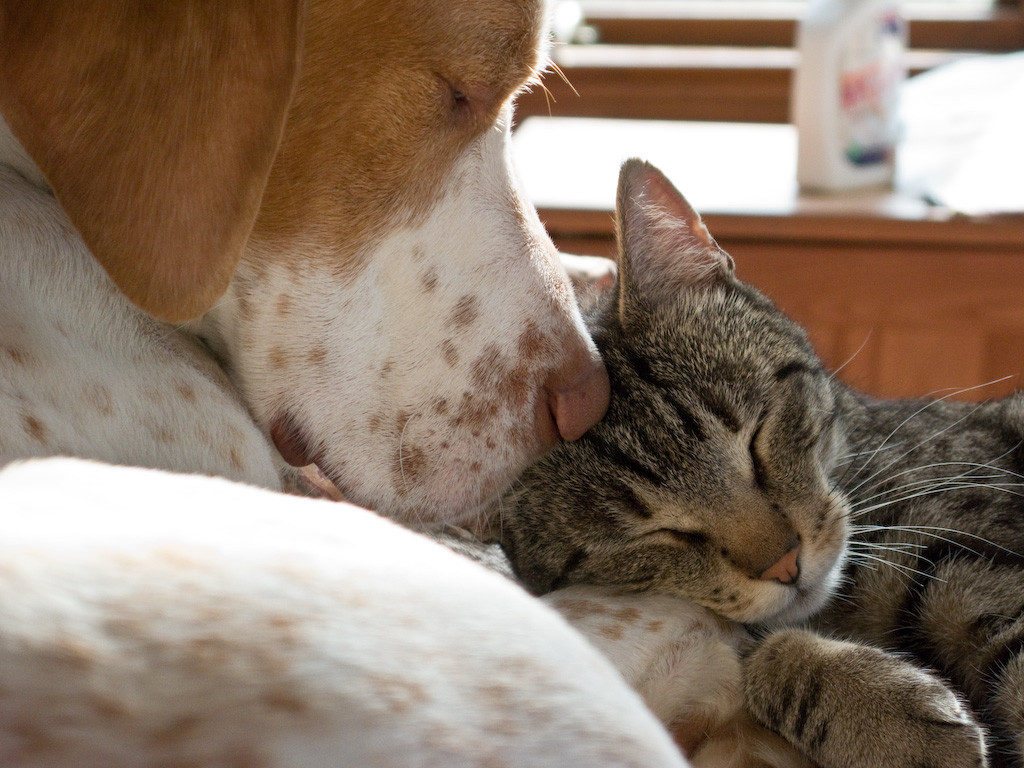For ages, the whimsical war of words has echoed through homes and hearts: Are cats the cunning masterminds, or do dogs reign supreme in the intelligence department? Dogs, with their tail-wagging obedience and trick-learning prowess, often seem like the academic achievers of the animal kingdom. Cats, on the other hand, with their enigmatic independence and hunting finesse, project an air of sophisticated self-reliance. But when it comes to raw brainpower, where does the truth lie?
To delve into this age-old question, PBS NewsHour sought the insights of three distinguished scientists: a neuroscientist specializing in brain structure, a dog cognition expert unraveling canine thought processes, and a cat behavior and cognition researcher dedicated to understanding feline minds. One of these scientists embarked on a unique quest, meticulously counting brain cells in these beloved pets, and the results pointed to a clear frontrunner. However, the ever-evolving field of animal intelligence research urges us to reconsider our traditional notions of what “smart” truly means.
Neurons Tell the Tale: Dogs Edge Out Cats in Brain Cell Count
Neuroscientist Dr. Suzana Herculano-Houzel, renowned for her innovative approach to studying animal intelligence, ventured deep into the gray matter itself. Her method? Liquefying animal brains to meticulously count their neurons, the fundamental units of information processing in the nervous system. Her groundbreaking findings revealed a striking difference: dogs possess approximately twice the number of neurons compared to their feline counterparts.
Dr. Herculano-Houzel’s team focused on the cerebral cortex, the brain’s intricately folded outer layer responsible for higher-level cognitive functions. They analyzed the brains of eight carnivorous mammal species, including cats, dogs, ferrets, mongooses, raccoons, hyenas, lions, and brown bears. The study, published in the journal Frontiers in Neuroanatomy in late 2017, utilized brains donated from zoos, wildlife preserves, rehabilitation facilities, and even pet owners – brains from animals that had already passed away.
 Suzana Herculano-Houzel with her dog Mielina, illustrating the neuron study and the question of dog versus cat intelligence.
Suzana Herculano-Houzel with her dog Mielina, illustrating the neuron study and the question of dog versus cat intelligence.
Alt text: Neuroscientist Suzana Herculano-Houzel poses with her dog Mielina, representing the research into neuron counts and the ongoing debate about canine and feline intelligence.
The technique pioneered by Dr. Herculano-Houzel, initially used to determine the neuron count in the human brain, involves transforming brain tissue into a liquid state, effectively creating a “brain soup.” This process isolates the nuclei of neurons, allowing researchers to accurately count them. Applying this method, the team discovered that dogs boast around 530 million cortical neurons, while cats have a more modest 250 million. To put this in perspective, the human cerebral cortex contains a staggering 16 billion neurons. Dr. Herculano-Houzel suggests that even smaller dog breeds, like Chihuahuas or Corgis, likely surpass cats in neuron numbers.
“The logical implication,” Dr. Herculano-Houzel concluded, “is that, yes, dogs are demonstrably more capable than cats in terms of neural processing power based on neuron count.”
Intriguingly, the study unveiled unexpected results beyond the cat-dog comparison. Larger animals like hyenas, lions, and brown bears surprisingly exhibited fewer neurons than smaller species. This challenges the long-held assumption in neuroscience that brain size directly correlates with intelligence – the bigger the brain, the smarter the animal. In fact, bears were found to have a similar number of cortical neurons as cats, despite their significant size difference.
Raccoons, often lauded for their cleverness, presented another fascinating anomaly. Their brains, comparable in size to a cat’s, packed as many neurons as a dog’s brain. The neuron density in raccoon brains even rivaled that of some primates.
“The remarkably high number of neurons we observed in raccoon cortices aligns perfectly with the anecdotal tales of raccoon ingenuity,” Dr. Herculano-Houzel noted. “It substantiates their reputation for being incredibly resourceful and adept at problem-solving, particularly when it comes to foraging for food.”
Dr. Herculano-Houzel’s team also examined neuron counts in herbivores, suspecting that plant-based diets might require less energy and brainpower, thus resulting in fewer neurons. However, they found that herbivores possessed a comparable number of neurons to their carnivorous counterparts. Similarly, no significant difference in neuron count was observed between domesticated and wild animals.
These findings collectively suggest that brain size is not the sole determinant of intelligence. Evolution and selective breeding haven’t rigidly favored specific species or body sizes in the pursuit of higher neuron counts. Intelligence, it appears, can manifest in creatures of all shapes and sizes, Dr. Herculano-Houzel emphasized.
Beyond Neuron Numbers: Exploring the Spectrum of Intelligence
Dr. Brian Hare, the founder and director of Duke University’s Canine Cognition Center, approaches the interspecies intelligence debate with caution. He points out that many scientists shy away from the term “intelligence” itself, as its measurement is often biased towards human-centric perspectives.
“Posing the question of which species is smarter is akin to asking if a hammer is a superior tool to a screwdriver,” Dr. Hare, who was not involved in Dr. Herculano-Houzel’s neuron study, explained via email. “Each tool is meticulously designed to tackle specific problems, so the answer unequivocally depends on the task at hand.”
Evolution has sculpted each species to excel at solving the challenges most critical to its survival and reproduction within its unique ecological niche, he elaborated. The image of a dolphin perched in a tree appears as absurd as a chimpanzee attempting to fish in the open ocean. However, research demonstrates that both dolphins and chimpanzees exhibit remarkable intelligence within their natural environments.
So, how can scientists effectively study animal cognition without resorting to a simplistic hierarchy of intelligence?
“Much of our current understanding of intelligence in diverse species falls along a gradient or a spectrum, rather than a linear scale,” explained Dr. Kristyn Vitale Shreve, a cat cognition and behavior research fellow at Oregon State University.
Consider hunting prowess as an example. Cats reside at the highly skilled end of the spectrum, dogs occupy the middle ground, and humans fall closer to the lower end. However, if we shift the focus to mathematical abilities, humans surge to the intelligent end, while cats and dogs recede.
In essence, directly comparing different species against each other is inherently flawed because they exhibit intelligence in fundamentally different ways, tailored to their specific needs and environments. Nonetheless, Dr. Vitale Shreve underscores the importance of comparative studies to explore how broad behavioral patterns correlate with brain physiology, especially in light of the new insights into neuron quantities across species.
 A dog and a cat together, emphasizing the importance of love and care regardless of neuron count or intelligence comparisons.
A dog and a cat together, emphasizing the importance of love and care regardless of neuron count or intelligence comparisons.
Alt text: A harmonious image of a dog and a cat side-by-side, symbolizing the message of love and affection for pets irrespective of neuron counts or comparative intelligence.
Both Dr. Vitale Shreve and Dr. Herculano-Houzel acknowledge the inherent difficulties in studying intelligence through behavioral experiments, which often involve animals performing artificial tasks or solving puzzles in controlled settings. Furthermore, direct cognitive comparisons between dogs and cats remain scarce, and surprisingly few researchers dedicate their efforts to feline cognition research in general. Dr. Vitale Shreve emphasizes that until scientists develop more refined and ecologically relevant methods for studying both dogs and cats in tandem, drawing definitive intelligence comparisons is inherently unfair and potentially misleading.
“There’s a prevailing misconception that cats are inherently untrainable or challenging to work with in research settings,” Dr. Vitale Shreve noted. “Cats exhibit significant individual variability and possess distinct personalities, which can pose unique challenges for researchers seeking to understand their cognitive abilities.”
In conclusion, intelligence is a multifaceted and intricate phenomenon. While neuron count suggests a potential advantage for dogs in terms of processing capacity, it’s crucial to recognize the diverse forms intelligence takes across species. Dr. Herculano-Houzel offers a heartwarming message for all pet lovers:
“Please shower your cats and dogs with equal affection and care,” she encourages. “Regardless of their neuron count, their capacity for love and companionship is immeasurable.”
